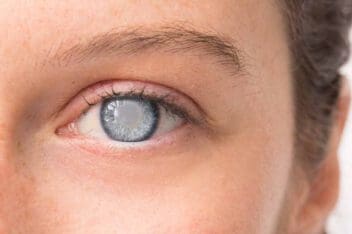Further Reading
Why Do Contacts Sometimes Cause Cloudy Vision? What to Do
Home / Understanding Contacts /
Last Updated:
Contacts are prescription medical devices that are placed inside the eye to correct refractive errors and improve vision. Sometimes, cloudy vision can be the result of contact lens use.
Table of Contents
Cloudy vision is when it seems like you are looking at things through a fog or haze. It can appear as if there is something between your eye and the world, kind of like looking through frosted glass. If you wear contacts, they may be the culprit.
Your contacts may be dirty, or dry or cloudy vision may indicate a deeper medical condition. Damage to the cornea (the outer layer of the eye) can be a cause of cloudy vision that may or may not be directly related to contact lens wear. Common causes of cloudy vision can also include cataracts, glaucoma, or macular degeneration.
Since cloudy vision can be related to many potential causes, treatment can vary as well. You may be able to simply change brands or types of contacts, or even just clean the ones you have, in order to improve cloudy vision. The issue may be more serious and require medical attention in some cases.

Causes of Contact-Related Cloudy Vision
Contacts are meant to help you see better and improve vision, but in some cases, they can cause vision-related issues. Cloudy vision is when there seems to be a fog or haze that is hard to see clearly through, and objects may not appear as clear as they should. One of the simple causes of contact-related cloudy or foggy vision is dirty or damaged contacts.
Contacts can be either soft or hard, reusable or disposable. Both can be defective in some way and have damage that may cause vision to be impaired. Soft contact lenses are more common than rigid, gas-permeable (RGP), hard contacts are, and soft lenses need to be disposed of on a regular schedule.
You deserve clear vision. We can help.
With 135+ locations and over 2.5 million procedures performed, our board-certified eye surgeons deliver results you can trust. Your journey to better vision starts here.
The Centers for Disease Control and Prevention (CDC) publishes that between 40 and 90 percent of people who wear contacts do not follow the care instructions for them and put themselves at risk for complications. For example, the American Optometric Association (AOA) reports that 45 percent of adults who wear contacts do not replace them as often as directed. Daily use disposable contacts are meant to be worn one time and discarded, for instance, and multi-day use or sleeping in daily use contacts can lead to infections or other eye complications.
Cloudy vision can be caused by dirty contacts that are not cleaned or disinfected properly. Contacts that do not fit properly or are not the right prescription may also result in impaired vision.
Cloudy vision may be the result of dirt or debris being trapped under the contact, which may be more common with RPG lenses. It could also result from a scratch on the surface of the contact lens.
Vision can also become cloudy when contacts are worn for too long, and the eyes get overly dry. With many types of contacts, especially soft contact lenses, oxygen does not pass as freely to the eye as it needs to. If the eyes are starved of oxygen for too long, such as overnight, they can become dry. Dry contacts can result in cloudy or blurred vision. AOA warns that long-term contact use can be a risk factor for dry eyes.
An injury to the cornea can cause cloudy or foggy vision. The American Academy of Ophthalmology (AAO) publishes that corneal swelling can cause halos to form around lights and possible cloudy vision, especially upon waking up in the morning.
Cloudy vision while wearing contacts may also be a symptom of a medical condition that needs to be addressed.
Symptoms of Cloudy Vision
Many signs and symptoms may point towards cloudy vision, depending on the underlying disease or condition. Symptoms that may accompany cloudy vision include:
- Dry eyes
- Blurred or double vision
- Glare around lights
- Poor nighttime vision
- Increased sensitivity to light
- Red (bloodshot) or sore eyes
- Eye itching or discharge
- Difficulty telling colors apart
Cloudy vision can also accompany symptoms of other body systems like headaches.
Possible Eye Problems Related to Cloudy Vision

Cloudy vision may not be directly related to contact use and may indicate a medical issue. There are various possible causes of cloudy vision and eye-related issues involving it.
- Cataracts
- Glaucoma
- Corneal infection or disease
- Macular degeneration
Cataracts are the most common reason for cloudy vision. Mayo Clinic explains that cataracts are most often related to aging; however, they can also form as a result of a medical condition like diabetes or an injury to the eye. If you start to experience cloudy vision and cleaning or changing your contacts does not seem to clear it up, it may be the result of cataract formation. This can occur in one or both eyes and may develop slowly over time.
Infections of the eye, such as conjunctivitis or pink eye, may also cause the eye to be irritated and result in cloudy vision. Eye infections are often the result of poor contact hygiene and improper care.
Fuchs’ dystrophy is a corneal disease that can cause cloudy vision. AAO reports that Fuchs’ dystrophy is a disease that involves the corneal layer that moves fluid through the eye and out of the cornea, the endothelium. As a result of the disease, the endothelium cells die off, and the cornea fills with fluid and swells up. Hazy vision may occur in the early stages of Fuchs’ dystrophy, and it is more common first thing in the morning. Progression of the disease will mean that cloudy vision persists throughout the day, and blisters can form, causing pain. Fuchs’ dystrophy and other corneal infections and diseases can be caught with regular eye exams.
Glaucoma is a disease that damages the optic nerve and may result in cloudy vision. The American Macular Degeneration Foundation (AMDF) publishes that macular degeneration is the number one cause of vision loss in the United States, and one of the symptoms of the disease can be blurred or cloudy vision.
If cloudy vision persists, does not improve with changing or removing your contacts, and is accompanied by other symptoms, such as eye pain, irritation, swelling, redness, or discharge, it is time to seek medical attention to find the source. Again, cloudy vision can be an indicator of an underlying medical condition.
How to Manage Cloudy Vision Related to Contacts

If you experience cloudy vision while wearing contacts, the first thing to do is take the contacts out. Cloudy vision is different from blurry vision. You may not be able to see clearly or focus precisely without your contacts, but it should also not appear that you are looking through fog either.
Try to clean your contacts by rubbing and rinsing them, using the correct disinfecting fluid. Your contacts should appear clear and transparent. If they are dirty, they may look hazy or milky, which can cause cloudy vision. It may be that you have a defective pair of contacts or that the brand or type of contact lens is not right for your eye. In this case, switching types or brands may do the trick.
Vision may become blurry or hazy as your prescription changes. This may be easy to fix with a new prescription. Your eye doctor can help you with this.
Dry contacts can result in hazy vision that may be cleared by using the proper wetting drops for your specific contacts. Be careful with regular saline or eye drops. Instead, only use the exact solution meant for your contact type and brand.
If cloudy vision continues even after taking out or changing your contacts, contact your eye doctor for an appointment. It may be the result of a more serious medical condition that needs to be treated with medications or surgical means.
Regular eye exams are important, as they can maintain eye health and identify a potential issue before it progresses.
You deserve clear vision. We can help.
With 135+ locations and over 2.5 million procedures performed, our board-certified eye surgeons deliver results you can trust. Your journey to better vision starts here.
Why Do My Contacts Get Cloudy?
Cloudiness in contact lenses is a phenomenon that many contact lens wearers might experience. It’s important to understand that having cloudy contacts is different than contacts that cause cloudy vision. Cloudy contacts refer to a physical alteration or residue on the lenses themselves, whereas cloudy vision due to contacts often relates to underlying eye health issues, improper fit, or inadequate care of the lenses.
Here are some common reasons why contacts may get cloudy:
- Protein and Lipid Buildup: The eye naturally produces proteins and lipids. Over time, these can accumulate on the surface of the contact lenses, creating a cloudy appearance.
- Improper Cleaning: Using the wrong cleaning solution or not following the cleaning instructions properly can lead to a residue on the contacts that appears cloudy.
- Age of the Contacts: Wearing contacts past their intended lifespan can lead to clouding.
- Environmental Factors: Exposure to smoke, dust, and other environmental irritants can cause deposits to form on the lenses, leading to a cloudy appearance.
- Water Exposure: Water from swimming pools, showers, or other sources can leave residue on the contacts, leading to cloudiness.
- Incorrect Lens Fit: If the contact lenses are not the correct size or shape for your eyes, they may not sit properly on the eye’s surface, leading to clouding.
- Incompatibility with Makeup or Skincare Products: Sometimes, personal care products can interact with the contact lenses, leading to a cloudy film.
If your contacts appear cloudy, start by cleaning and disinfecting them according to the instructions provided by your eye care professional or the manufacturer. If the problem persists, it may be time to replace the contacts with a fresh pair. Continuous problems with cloudy contacts should be addressed with an eye care professional, as it may indicate a larger issue with the type or fit of the lenses.
FAQs
Should you change your contacts if you have cloudy vision?
You can change the type of contacts brands you have or clean the ones you are already using to try and improve cloudy vision. Sometimes, your contact lenses may have scratches or react with your eyes when in use. In such instances, trying a different brand or type of contact lenses could help.
However, it is always best to go for an eye checkup and seek advice from your eye care provider. The issue may be more serious than you anticipate.
Should you switch to glasses if you have cloudy vision?
You can always switch to glasses if you have cloudy vision when using contacts. This is one of the easiest ways to know if your contacts are faulty or there’s some underlying eye condition you do not know about.
If you see clearly with glasses, then it may just be that your contact lenses were dirty or have scratches. But if cloudy vision continues after changing from contacts to glasses, ensure you contact your eye care doctor for an appointment.
Is cloudy vision normal?
Having cloudy vision is not normal. If you start experiencing cloudy vision, make sure you get it checked out. While cloudy vision does not necessarily signal refractive error, it is still not normal to see things murky, hazy, oily, or out of focus.
Such a concern might also be as a result of other reasons like cataracts, glaucoma, macular degeneration, lack of enough sleep, or a reaction to your contacts.
You deserve clear vision. We can help.
With 135+ locations and over 2.5 million procedures performed, our board-certified eye surgeons deliver results you can trust. Your journey to better vision starts here.
References
- Facts and Stats. (August 2017). American Optometric Association.
- Dry Eye. (2019). American Optometric Association.
- Can You Explain Why I Have Halos and Blurry Vision in the Morning? (June 2017). American Academy of Ophthalmology.
- Cataracts. (June 2018). Mayo Clinic.
- What Is Fuchs’ Dystrophy? (September 2017). American Academy of Ophthalmology.
- What Is Macular Degeneration? American Macular Degeneration Foundation.
This content is for informational purposes only. It may have been reviewed by a licensed physician, but is not intended to serve as a substitute for professional medical advice. Always consult your healthcare provider with any health concerns. For more, read our Privacy Policy and Editorial Policy.